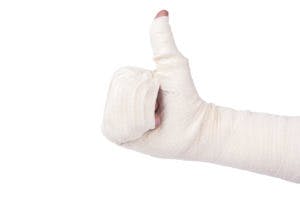It seems like common sense—everybody falls, no matter what age. However, for many older adults, an unexpected fall can result in a serious and costly injury. The good news is that most falls can be prevented. And one of the ways you can prevent a fall is by knowing who you can call on for help.
That’s why falls prevention should be a team effort, where each member of the team offers expertise in their area of responsibility or field of work. Some members include health care professionals, like your primary care physician, an occupational therapist, physical therapist, pharmacists, and more. While health care professionals provide much of the expertise and experience to ensure you live independently and falls free, there are other resources in your community that contribute to falls prevention.
Let’s get to know your falls prevention team
From medication and vision impairment to poor lighting and chronic conditions, the factors to watch for are numerous. That’s why having a team to help spot and address fall risks is so helpful. Below are all of the resources that play a significant role in promoting safety and preventing falls for you.
Your falls prevention team should include:
Each of them brings a unique mix of expertise and familiarity that can provide important protections against falling. Check out this video to learn more.

Your family and friends
You know them, you trust them, and they are happy to help. Family and friends provide some extra hands or another set of eyes to check and rid your home of falls hazards. The next time they come over to visit or help around the house, ask them to take a little extra time helping you find common fall hazards. This checklist shows you what to look for. Family and friends can also join you during doctor visits and help ask questions and gather information about prevention falls.
Your occupational therapist (OT)
Whether you’re already working with an OT or not, they are a vital part of any falls prevention team. They can ensure your assistive devices fit your needs and assess your home to identify hazards to be eliminated and modifications that can prevent falls. During Falls Prevention Awareness Day a few years ago, we toured a real home with Scott Trudeau, PhD, OTR/L from the American Occupational Therapy Association. The video is a wonderful example of how teamwork can prevent falls.
Your primary care physician (PCP)
Primary care physicians are often best positioned to work with patients on falls prevention and get the process started because they see patients regularly. Your PCP knows your medical history and manages chronic illness like diabetes and arthritis that may put you at risk. PCPs can recommend evidence-based programs designed to reduce fall risk, spot hidden injuries resulting from a fall, and evaluate side-effects and other problems with medications that may increase your risk of falling.
Be proactive about addressing falls when you visit your doctor. Even if your appointment was made for something else, sharing information is always important. Tell your doctor if you’ve fallen recently, feel unsteady on your feet or are worried about falling. A good PCP wants to build trust and be accurate so you stay healthy.
Your pharmacist
Most older adults take some kind of medication or supplement each day. The effects of medications on our risk of falling isn’t usually something we think about when we’re trying to get over a cold or manage disease like high blood pressure or arthritis. That’s why pharmacists are an important part of any falls prevention team. When you pick up your medications, use the opportunity to get counseled about any side effects you’re experiencing, and any changes in the medications you’re taking. Check out this video which explore the role of medications in falls and the many ways that pharmacists can help.
Your physical therapist (PT)
Physical therapists are important members of the falls prevention team. They can work with you to improve balance, strength, and mobility to prevent falls and can help address the reasons you may be feeling unsteady. Physical therapists can also help you identify what you can do each day to manage your falls risk and connect you to resources in the community to maintain and improve your strength and balance.
Your fire department
Your local fire department can play a key role in falls prevention and do more than help you in case you do fall. Fire departments can help prevent falls by offering home safety checks to spot falls hazards*, such as rugs without non-slip backing or too many electrical devices plugged into one outlet. They also can assist in testing and replacing smoke alarms. Firefighters can also connect you to resources in the community to prevent falls. View this infographic to learn more tips on how the fire department can help reduce your risk of falls.
Your senior center
Senior centers are local community-based meeting places where you can gather to enjoy recreational, social, cultural, health and wellness and educational programs to remain physically active, learn new things, and stay engaged with the community. They connect you to a broad array of community services like transportation, nutrition, and benefits access. Senior centers also are a trusted community hub for health and fitness programs to encourage exercise and movement.
Your hardware store
You can find household goods and many other home products and appliances to maintain and improve your home at any local hardware store. Your hardware store is the ideal one-stop shop if you want to make modifications to your home to reduce your risk of falls. They have all the supplies and materials needed to make your home a safe and comfortable place to age in place and remain independent, such as grab bars, a hand-held shower head, nightlights and lightbulbs for brighter light, and nonslip pads for your rugs. They can also help you find what you need to make these recommended home modifications. Installing a walk-in bathtub can also make bathing easier and safer.
Your faith-based organization(s)
You can depend on your faith-based organization to support and encourage you along your falls prevention journey. Faith leaders are trusted sources of important information and can connect you to community resources to address your needs, especially when it comes to your health. You can also count on your faith community for social support, whether it is joining you in a new activity, preparing for a medical visit, or going along with you to a falls screening or other falls prevention event.
Your library
Libraries are a valuable place to learn about falls prevention. They are filled with books and other media for you to use so you can be more informed and educated about your health. Library staff can also help you find specific information on falls risk factors and often know about important community events and other resources. Libraries are also a common place for falls prevention programming, such as A Matter of Balance, Tai Chi, and Bingocize!
Your local sporting goods store
Your local sporting goods store is a valuable resource for the most appropriate shoes, clothes, and equipment to help you stay active and falls free. These stores can help you pick out the best shoes for walking, hiking, and other exercise activities. Sporting goods stores can also help you pick out the right equipment for health and fitness programs, such as yoga mats, ankle weights, dumbbells, walking sticks, and more. They also carry water bottles and specialized clothing to help you stay cool during the summer and warm during the winter.
Ready to build your falls prevention team?
As you start to pull together those who will help you protect your health and independence, you can always turn to organizations like ours for information. Falls Prevention Awareness Week only happens once a year, but we are constantly creating new resources for older adults, caregivers, and professionals to use whenever you need. Check out NCOA’s Falls Free CheckUp, a quick 12-question screen to help you better understand your risk for falling.
Falls Prevention Awareness Week is made possible in part by grant number 90FPSG0051 from the U.S. Administration for Community Living, Department of Health and Human Services, Washington, D.C. 20201. Grantees undertaking projects under government sponsorship are encouraged to express freely their findings and conclusions. Points of view or opinions do not, therefore, necessarily represent official Administration for Community Living policy.
*Carousel PT offers home safety checks, such as evaluating proper nighttime lighting and clear paths of travel to restrooms when falls are the highest risk, and much more.




